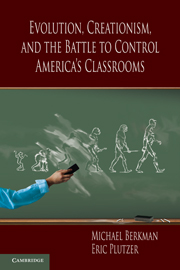Book contents
- Frontmatter
- Contents
- Figures
- Tables
- Acknowledgments
- Introduction
- 1 Who Should Decide What Children Are Taught?
- 2 The Public Speaks: “Teach Both”
- 3 A Nation Divided by Religion, Education, and Place
- 4 Is Evolution Fit for Polite Company? Science Standards in the American States
- 5 Teachers and What They Teach
- 6 State Standards Meet Street-Level Bureaucracy
- 7 When the Personal Becomes Pedagogical
- 8 Teachers in Their Schools and Communities
- 9 The Battle for America’s Classrooms
- Appendix to Chapter 2
- Appendix to Chapter 3
- Appendix to Chapter 4
- Appendix to Chapter 5
- Appendix to Chapter 6
- References
- Judicial Opinions and Court Cases Cited
- Index
2 - The Public Speaks: “Teach Both”
Published online by Cambridge University Press: 05 June 2012
- Frontmatter
- Contents
- Figures
- Tables
- Acknowledgments
- Introduction
- 1 Who Should Decide What Children Are Taught?
- 2 The Public Speaks: “Teach Both”
- 3 A Nation Divided by Religion, Education, and Place
- 4 Is Evolution Fit for Polite Company? Science Standards in the American States
- 5 Teachers and What They Teach
- 6 State Standards Meet Street-Level Bureaucracy
- 7 When the Personal Becomes Pedagogical
- 8 Teachers in Their Schools and Communities
- 9 The Battle for America’s Classrooms
- Appendix to Chapter 2
- Appendix to Chapter 3
- Appendix to Chapter 4
- Appendix to Chapter 5
- Appendix to Chapter 6
- References
- Judicial Opinions and Court Cases Cited
- Index
Summary
The people, as a rule, do not believe in the ape theory.
William Jennings Bryan (1924)Understanding how the Gallup poll induced such opinions about the creationism issue in this case provides an object lesson as to how an illusion of public opinion can be generated in public opinion surveys generally.
George Bishop (2005)But we decide which is right.
And which is an illusion?
The Moody Blues (1967)
Opponents of evolution have claimed for nearly a century that public opinion is on their side. The proponents of the nation's first anti-evolution laws in the 1920s were confident that these laws would be popular with voters and reflected majority sentiment. In the latter half of the twentieth century, state legislators and school board members could also claim citizen support for policies that mandated “balanced treatment” for evolution and creationism and, later, that mandated the teaching of intelligent design or curricula that emphasized “gaps” in the theory of evolution. As we noted in Chapter 1, both populists like Bryan and strict constructivists like Scalia have made strong normative cases for following the wishes of the majority, even against the strong objections of scientific or pedagogical experts. Thus, it is essential to understand the policy preferences of ordinary citizens.
In this chapter, we marshal evidence from more than a quarter century of surveys of the American public concerning evolution. We will begin with the public's policy preferences – what Americans say that they want taught in public schools. This review will show that the majority of Americans favor teaching students a biblical perspective on the origins of life on earth. For most, creationism should be taught alongside evolutionary biology – what many refer to as “balanced treatment.” However, a fairly sizable minority say they want biblical perspectives to supplant scientific treatments of the origin of species.
- Type
- Chapter
- Information
- Publisher: Cambridge University PressPrint publication year: 2010



